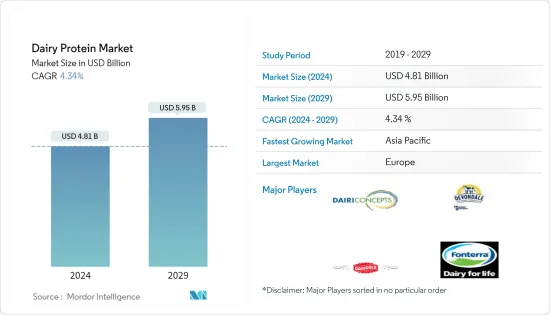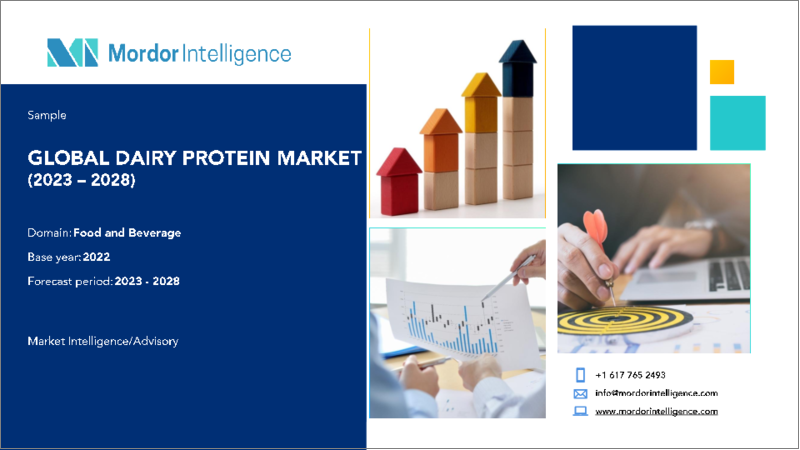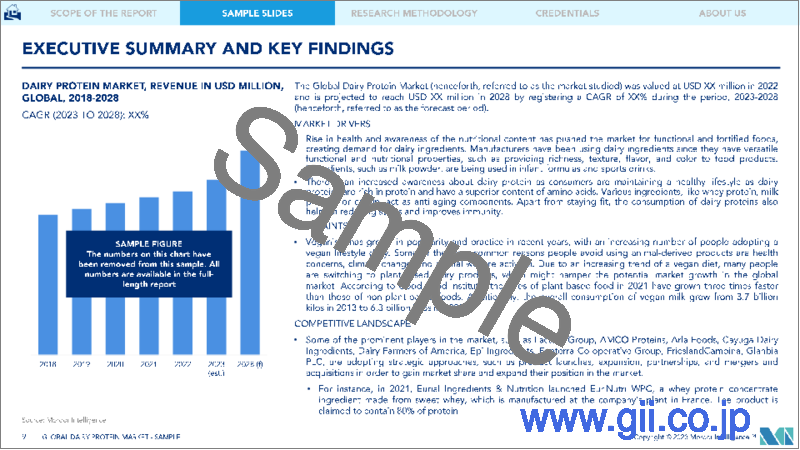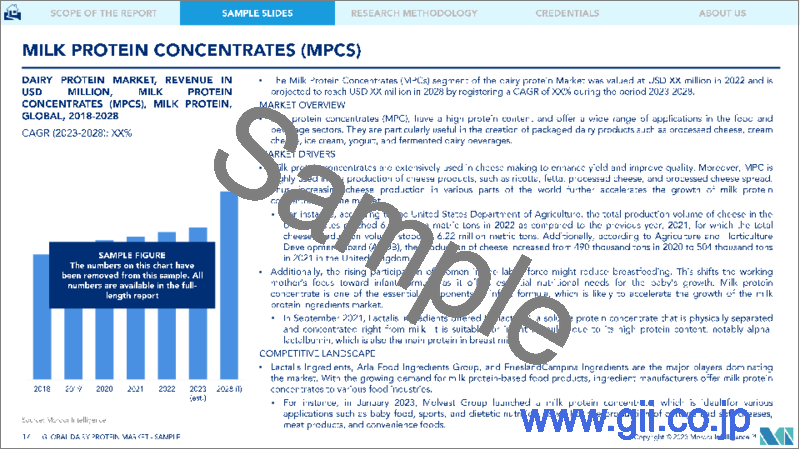|
|
市場調査レポート
商品コード
1444775
乳製品タンパク質の世界市場:市場シェア分析、産業動向・統計、成長予測(2024~2029年)Dairy Protein - Market Share Analysis, Industry Trends & Statistics, Growth Forecasts (2024 - 2029) |
||||||
|
● お客様のご希望に応じて、既存データの加工や未掲載情報(例:国別セグメント)の追加などの対応が可能です。 詳細はお問い合わせください。 |
|||||||
| 乳製品タンパク質の世界市場:市場シェア分析、産業動向・統計、成長予測(2024~2029年) |
|
出版日: 2024年02月15日
発行: Mordor Intelligence
ページ情報: 英文 110 Pages
納期: 2~3営業日
|
- 全表示
- 概要
- 目次
世界の乳製品タンパク質の市場規模は、2024年に48億1,000万米ドルに達し、2024~2029年の予測期間中にCAGR 4.34%で成長し、2029年までに59億5,000万米ドルに達すると予測されております。

主なハイライト
- 乳製品タンパク質、カゼイン、ホエイタンパク質などの乳製品タンパク質は、健康にさまざまな栄養的および機能的利点をもたらすタンパク質の供給源です。
- その後、乳製品タンパク質の消費量が増加し、牛乳が最も豊富で最も人気のあるタンパク質源となっています。乳製品タンパク質の味は、新しく成長しているベジタリアンタンパク質よりも豊かであり、これが乳製品タンパク質市場の需要の主な促進要因です。
- 健康意識の高まりとスポーツ栄養に対する需要が世界市場を牽引する主な要因となっています。
乳製品タンパク質の市場動向
健康食品に対する意識の高まり
- 乳製品タンパク質業界は、消費者が満腹感、体重管理、筋肉の健康などの高タンパク質ダイエットの利点を達成できるよう支援できるため、人気が急上昇しています。
- 健康や福祉に対する意識の高まり、生活習慣病や肥満の有病率の上昇、健康志向の消費者の増加など、いくつかの要因が業界の成長を推進しています。さらに、世界的に急速に増加している高齢者人口は、ヘルスケア費や加齢に伴う筋肉の減少と闘うことを求めており、乳製品タンパク質製品の需要がさらに高まっています。
- さらに、都市化の傾向と労働力への女性の参加の増加は母乳育児率の低下につながる可能性があり、その結果、乳児の必須栄養源として乳児用調製粉乳に焦点が移る可能性があります。
- 乳児用調製粉乳の重要な成分である乳製品タンパク質濃縮物は、乳製品タンパク質原料市場の成長に大きく貢献すると期待されています。新興国や新興諸国における中間層人口の増加により、働く母親のスケジュールに対応できる製品のニーズが高まっており、乳児栄養市場に新たな機会が生まれています。
- 市場は、米国食品医薬品局(米国FDA)による承認の増加と主要企業による製品発売によって後押しされると予想されています。たとえば、2021年 9月に、Lactalis Materialsは、牛乳から直接抽出して濃縮した可溶性タンパク質濃縮物であるProlacta 80を導入しました。タンパク質含有量が高く、特に母乳中の主要タンパク質でもあるアルファ-ラクトアルブミンは、乳児用調製粉乳の理想的な成分となっています。したがって、健康志向の消費者の増加や栄養価の高い乳児用調製粉乳のニーズの高まりなどのこれらの要因が、乳製品タンパク質市場の成長を促進すると予想されます。
欧州は乳製品タンパク質市場で主要なシェアを保持
- 欧州は現在、世界の乳製品タンパク質市場で最大の市場シェアを保持しており、この分野の主要市場となっています。北米は欧州に続き、第2位の市場シェアを保持しています。一方、アジア太平洋は人口が多く、スポーツ栄養や機能性飲料の需要が急増しているため、最も急速に成長している市場です。南米とアジアの新興諸国は、これらの地域の若年層が栄養補助食品やボディビルディングのためにホエータンパク質を広く摂取しているため、最も魅力的な市場となっています。
- ヨーグルトやチーズなどの乳製品は、欧州や西側の市場で人気があります。ホエイタンパク質を注入したヨーグルトは、消化の改善や腸内細菌叢の回復などの健康上の利点が追加されるため、世界中で需要が高まっています。さらに、乳製品タンパク質は優れた機能的特性と高い栄養価を持っています。乳製品産業は、世界経済、特に欧州連合(EU)にも大きく貢献しています。欧州委員会の牛乳市場監視機関によると、EUは2020年に50万トン以上のホエイパウダーを輸出しました。さらに、国内の健康意識の高まりに伴い、飲料中のホエイタンパク質の需要が高まっています。消費者が炭酸飲料よりも健康的な選択肢を選ぶようになったため、タンパク質ウォーターやエナジードリンクなどの製品が動向になりつつあります。その結果、企業はこの市場セグメントで革新的な製品を発売しています。たとえば、EurialIngredients & Nutritionは、2021年にフランスの同社工場で製造されたスイートホエイから調製された、タンパク質含有量80%のホエイタンパク質濃縮原料であるEuriNutriWPCを発売しました。これらの要因により、予測期間中の加工食品およびインスタント食品(RTE)における乳製品タンパク質の需要が高まります。
- ドイツも、食品・飲料業界でのタンパク質消費量の多さが原動力となり、市場をリードする国です。チーズは包装食品の中で最も細分化されており、ドイツの消費者の間で消費率が高いカテゴリーです。食糧農業機関法人統計データベース(FAOSTAT)によると、2021年のドイツの一人当たりチーズ消費量は約25.3キログラムでした。
- チーズ市場は、カルシウム、リン、亜鉛、ビタミンA、ビタミンB12などの優れた栄養素源に対する意識の高まりによって動かされており、これらは強い骨や、強い筋肉に不可欠な構成要素となる特定の高品質タンパク質の構築に不可欠です。したがって、チーズは乳製品タンパク質が豊富な製品の1つであると考えられています。ホエイタンパク質分離物(WPI)はチーズ製造プロセスの製品別であり、ホエイ濃縮物よりも多くのタンパク質が含まれています。したがって、チーズ生産の増加により、この地域の乳製品タンパク質市場の生産が促進されます。
- さらに、ホエイタンパク質濃縮物(WPC)、ホエイタンパク質分離物(WPI)(WPI)、および乳製品由来のホエイは、すぐに飲めるタンパク質シェイクや高タンパク質の食事代替品の製造に選ばれる原料となっています。たとえば、国家統計局(英国)によると、2021年に英国で製造されたタンパク質濃縮物の総販売額は4億6,300万英国ポンドを超えました。
- 乳製品タンパク質の摂取に伴う健康上の利点に対する消費者の意識の高まりによる、特に選択による乳製品タンパク質の利用率の高さは、欧州の乳製品タンパク質市場を推進する重要な要因の1つです。
乳製品タンパク質業界の概要
世界の乳製品タンパク質市場は競争が激しく、地域内および国際的な競合企業が存在します。市場の主要企業には、Fonterra Co-operative Group Limited、Glanbia PLC、Royal FrieslandCampina NVなどがあります。その他の主要企業には、Lactalis Group、Kerry Group PLC、Bonafarm Groupなどがあります。
競争力を高めるために、これらの企業は、製品の発売、市場での存在感の拡大、パートナーシップ、合併と買収などのさまざまな戦略的アプローチを採用しています。これらの戦略により、市場シェアを獲得し、市場における地位を強化することができます。
その他の特典
- エクセル形式の市場予測(ME)シート
- 3か月のアナリストサポート
目次
第1章 イントロダクション
- 調査の成果
- 調査の前提条件
- 調査範囲
第2章 調査手法
第3章 市場力学
- 市場促進要因
- 市場抑制要因
- ポーターのファイブフォース分析
- 新規参入業者の脅威
- 買い手の交渉力
- 供給企業の交渉力
- 代替製品の脅威
- 競争企業間の敵対関係の激しさ
第4章 エグゼクティブサマリー
第5章 市場セグメンテーション
- 材料
- 乳製品タンパク質濃縮物(MPC)
- ホエイタンパク質濃縮物(WPC)
- ホエイタンパク質分離物(WPI)
- 乳製品タンパク質分離物(MPI)
- カゼイン・カゼイン酸塩
- その他の材料
- 用途
- スポーツ栄養学
- 乳児用調製粉乳
- 機能性食品・栄養補助食品
- 医薬品
- 飼料・ペットフード
- その他の用途
- 地域
- 北米
- 米国
- カナダ
- メキシコ
- その他の北米
- 欧州
- 英国
- ドイツ
- フランス
- ロシア
- イタリア
- スペイン
- その他の欧州
- アジア太平洋
- インド
- 中国
- 日本
- オーストラリア
- その他のアジア太平洋
- 南米
- ブラジル
- アルゼンチン
- その他の南米
- 中東・アフリカ
- アラブ首長国連邦
- サウジアラビア
- その他の中東・アフリカ
- 北米
第6章 競合情勢
- 最も採用されている戦略
- 市場シェア分析
- 企業プロファイル
- Fonterra Co-operative Group Limited
- Glanbia PLC
- Groupe Lactalis
- Kerry Group
- Royal FrieslandCampina NV
- Prolactal GmbH
- Groupe Sodiaal
- Bonafarm Group
- Dairy Farmers of America
- Hoogwegt International BV
第7章 市場機会と将来の動向
第8章 出版社について
The Dairy Protein Market size is estimated at USD 4.81 billion in 2024, and is expected to reach USD 5.95 billion by 2029, growing at a CAGR of 4.34% during the forecast period (2024-2029).

Key Highlights
- Dairy proteins, such as milk protein, casein, and whey protein are the sources of proteins offering various nutritional and functional benefits on health.
- The dairy protein consumption has subsequently increased with milk being the richest and the most popular source of protein. The taste of dairy protein is richer than the newly-growing vegetarian proteins, which is the main driving factor for the dairy protein market demand.
- The increased health awareness and demand for sports nutrition are the major factors driving the global market.
Dairy Protein Market Trends
Growing Awareness Towards Healthy Food
- The dairy protein industry is experiencing a surge in popularity due to its ability to assist consumers in achieving the benefits of higher-protein diets, including satiety, weight management, and muscle health.
- Several factors are driving the growth of the industry, such as increased awareness of health and well-being, the rising prevalence of lifestyle diseases and obesity, and the growing number of health-conscious consumers. Additionally, the senior population, which is rapidly increasing globally, is seeking to combat healthcare costs and age-related muscle loss, further fueling the demand for dairy protein products.
- Moreover, the trend towards urbanization and the increased participation of women in the labor force may lead to a reduction in breastfeeding rates, which could result in a shift in focus towards infant formula as a source of essential nutrition for babies.
- Milk protein concentrate, which is a critical component of infant formula, is expected to significantly contribute to the growth of the dairy protein ingredients market. The growing middle-class population in emerging and developing countries is creating new opportunities in the infant nutrition market, as the need for products that can accommodate the schedules of working mothers is on the rise.
- The market is expected to experience a boost from the increasing approvals by the United States Food and Drug Administration (US FDA) and product launches by key players. For instance, in September 2021, Lactalis Ingredients introduced Prolacta 80, a soluble protein concentrate that is extracted and concentrated directly from milk. Its high protein content, particularly alpha-lactalbumin, which is also the primary protein in breast milk, makes it an ideal ingredient for infant formula. Therefore, these factors, including growing health-conscious consumers and the increasing need for nutritious infant formulas, are expected to drive the growth of the dairy protein market.
Europe holds the Major Share in Dairy Protein Market
- Europe currently holds the largest market share in the global dairy protein market and is the primary market for this sector. North America follows Europe, holding the second-largest market share. Meanwhile, Asia-Pacific is the fastest-growing market due to its large population and the surging demand for sports nutrition and functional beverages in the region. Developing countries in South America and Asia present the most attractive markets, as the younger population in these regions extensively consumes whey protein as dietary supplements and for bodybuilding.
- Dairy products such as yogurt and cheese are popular in European and Western markets. Yogurts infused with whey protein are witnessing enhanced demand worldwide due to their added health benefits, including improving digestion and restoring intestinal flora. Additionally, dairy proteins have excellent functional properties and high nutritional values. The dairy industry also significantly contributes to the world economy, particularly in the European Union (EU). According to the milk market observatory of the European Commission, the EU exported over 500,000 tons of whey powders in 2020. Moreover, whey protein demand in beverages is rising with the growing health awareness in the country. Products such as protein water and energy drinks are becoming a trend as consumers are choosing healthier options over carbonated beverages. As a result, companies are launching innovative products in this market segment. For instance, in 2021, EurialIngredients & Nutrition launched EuriNutriWPC, a whey protein concentrate ingredient with 80% protein content, prepared from sweet whey manufactured at the company's plant in France. These factors fuel the demand for dairy protein in processed and ready-to-eat (RTE) food products during the forecast period.
- Germany is another leading country in the market, driven by high protein consumption in the food and beverage industry. Cheese is the most fragmented category within packed food that has a larger consumption rate among German consumers. According to Food and Agriculture Organization Corporate Statistical Database (FAOSTAT), per capita cheese consumption in Germany was about 25.3 kilograms in 2021.
- The cheese market is driven by increased awareness of good sources of nutrients such as calcium, phosphorous, zinc, vitamin A, and vitamin B12, which are vital for building strong bones and certain high-quality proteins that provide essential building blocks for strong muscles. Therefore, cheese is considered one of the products that is rich in dairy protein. Whey protein isolate is a byproduct of the cheesemaking process that contains more protein than whey concentrate. Hence, the increase in cheese production drives the production of the dairy protein market in this region.
- Furthermore, whey protein concentrates (WPC), whey protein isolates (WPI), and dairy-derived whey have become ingredients of choice in manufacturing ready-to-drink protein shakes and high-protein meal replacements. For instance, according to the Office for National Statistics (UK), in 2021, the total sales value for protein concentrates manufactured in the United Kingdom surpassed 463 million British pounds.
- The high utilization of dairy protein, particularly by choice, due to increased consumer awareness of the health benefits associated with its consumption, is one of the key factors driving the dairy protein market in Europe.
Dairy Protein Industry Overview
The global dairy protein market is highly competitive and includes both regional and international competitors. Major players in the market include Fonterra Co-operative Group Limited, Glanbia PLC, and Royal FrieslandCampina NV. Other notable players include Lactalis Group, Kerry Group PLC, and Bonafarm Group.
To gain a competitive edge, these companies are adopting various strategic approaches, such as product launches, expanding their market presence, partnerships, and mergers and acquisitions. These strategies allow them to gain market share and strengthen their position in the market.
Additional Benefits:
- The market estimate (ME) sheet in Excel format
- 3 months of analyst support
TABLE OF CONTENTS
1 INTRODUCTION
- 1.1 Study Deliverables
- 1.2 Study Assumptions
- 1.3 Scope of the Study
2 RESEARCH METHODOLOGY
3 MARKET DYNAMICS
- 3.1 Market Drivers
- 3.2 Market Restraints
- 3.3 Porter's Five Forces Analysis
- 3.3.1 Threat of New Entrants
- 3.3.2 Bargaining Power of Buyers/Consumers
- 3.3.3 Bargaining Power of Suppliers
- 3.3.4 Threat of Substitute Products
- 3.3.5 Intensity of Competitive Rivalry
4 EXECUTIVE SUMMARY
5 MARKET SEGMENTATION
- 5.1 Ingredients
- 5.1.1 Milk Protein Concentrates (MPCs)
- 5.1.2 Whey Protein Concentrates (WPCs)
- 5.1.3 Whey Protein Isolates (WPIs)
- 5.1.4 Milk Protein Isolates (MPIs)
- 5.1.5 Casein and Caseinates
- 5.1.6 Other Ingredients
- 5.2 Application
- 5.2.1 Sports Nutrition
- 5.2.2 Infant formulations
- 5.2.3 Functional Food & Dietary supplement
- 5.2.4 Pharmaceutical
- 5.2.5 Animal Feed/Pet Food
- 5.2.6 Other Applications
- 5.3 Geography
- 5.3.1 North America
- 5.3.1.1 United States
- 5.3.1.2 Canada
- 5.3.1.3 Mexico
- 5.3.1.4 Rest of North America
- 5.3.2 Europe
- 5.3.2.1 United Kingdom
- 5.3.2.2 Germany
- 5.3.2.3 France
- 5.3.2.4 Russia
- 5.3.2.5 Italy
- 5.3.2.6 Spain
- 5.3.2.7 Rest of Europe
- 5.3.3 Asia Pacific
- 5.3.3.1 India
- 5.3.3.2 China
- 5.3.3.3 Japan
- 5.3.3.4 Australia
- 5.3.3.5 Rest of Asia-Pacific
- 5.3.4 South America
- 5.3.4.1 Brazil
- 5.3.4.2 Argentina
- 5.3.4.3 Rest of South America
- 5.3.5 Middle East & Africa
- 5.3.5.1 United Arab Emirates
- 5.3.5.2 Saudi Arabia
- 5.3.5.3 Rest of Middle East & Africa
- 5.3.1 North America
6 COMPETITIVE LANDSCAPE
- 6.1 Most Adopted Strategies
- 6.2 Market Share Analysis
- 6.3 Company Profiles
- 6.3.1 Fonterra Co-operative Group Limited
- 6.3.2 Glanbia PLC
- 6.3.3 Groupe Lactalis
- 6.3.4 Kerry Group
- 6.3.5 Royal FrieslandCampina NV
- 6.3.6 Prolactal GmbH
- 6.3.7 Groupe Sodiaal
- 6.3.8 Bonafarm Group
- 6.3.9 Dairy Farmers of America
- 6.3.10 Hoogwegt International BV




